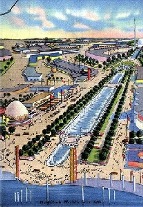|
The New York World Exposition 1939 & 1940
From Rubbish Dump to Park Land
|
Year: | 1939 | | City: | New York | | Country: | USA | | Duration: | 30th April - 31st October 1939 und 11th |
|
1
| 
Copyright: |
|
Site
The area designated for the World Fair was situated in the geographical heart of New York and only a 20 minute subway trip from Manhattan’s centre. But for years the Long Island Rail Road Company had used the marshy area as a scrap yard. Considerable efforts were required to turn the rubbish dump into the park Flushing Meadows. The road link with Long Island – Grand Central Parkway - already cut through the approximately 5.5 km long area and a railway was close by, but now they had to move thousands of tons of scrap, to level down the rubbish mountain ‘Mount Corona’, drain the marsh, lay down water, gas and electric mains and plant 10,000 large trees within 3 years in the biggest landscaping project of the Eastern USA. Two large lakes structured the area. The driving force behind the landscaping project was the Head of New York’s Parks Commission, Robert Moses, who wanted to keep the site as a Park after the World Fair. He designed a transportation concept for the area allowing access by car, rail, subway and from the waterside.
The terrain was divided into nine zones. In the middle was the Theme Center with the landmarks Trylon and Perisphere, around it the zones for Communications and Business systems, Community interest, Food, Administration, Medicine and Health, Production and Distribution, Science and Education and Transportation. The main axis was called Constitution Mall. It linked Trylon and Perisphere to Washington Square that was dominated by a 18-metres-high statue of the first American President by James Earle Fraser, and further to the Lake of Nations around which the national pavilions were grouped. A large boulevard separated the Amusement Area on the south side from the main site. A colour scheme was to help visitors with on-site orientation: buildings were painted in light colours around the gleaming white landmarks, the further away you got the darker the buildings were. The official Guide Book stated that thanks to this scheme “the visitor [was] to escape, for the first time, much of the mental confusion and the physical exhaustion which have invariably hindered his previous attempts to see and understand a great exposition.”
Robert Moses did not get his plan realised in the first attempt – due to lack of funds the organisers did not have the money to turn the exhibition site into a park. Only in 1964, after the second World Fair on the site when Moses himself was in charge, he could realise his dream and create a park that New Yorkers today frequent because of the large tennis and baseball facilities.
|



